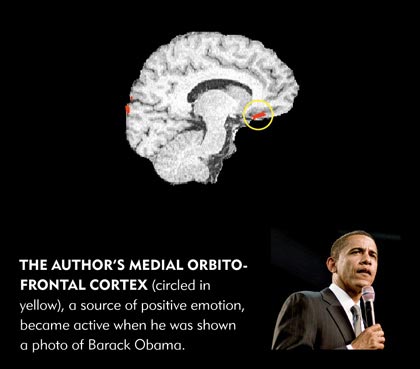 The other day, in a Psychology in the News post, I linked to an article in The New Yorker (by Jeffery Goldberg) called My Amygdala, My Self. The article proposed to be an examination of how brain scans can reveal preferences and biases, a field referred to as neuromarketing.
The other day, in a Psychology in the News post, I linked to an article in The New Yorker (by Jeffery Goldberg) called My Amygdala, My Self. The article proposed to be an examination of how brain scans can reveal preferences and biases, a field referred to as neuromarketing.Bill Knapp, a Democratic political consultant and co-owner of the brain-based marketing firm FKF Applied Research.
Here is a lengthy quote.
Read the whole article.The Atlantic experiment begins with a video clip of Jimmy Carter speaking about Hamas—a sequence guaranteed to provoke anxiety in a guy like Goldberg. Sure enough, the subject shows strong, bilateral activity in the amygdala, a structure associated with the panic response. "Jeff, do you fear this guy?" asks Iacoboni.
But studies have shown that the neurons of the amygdala can also fire off when someone experiences happiness, sexual arousal, or an intense aroma (among many other things). So, why do we think that Jimmy Carter makes Goldberg feel anxious instead of horny? Because we already know how he feels about Jimmy Carter.
This circular reasoning throws the whole endeavor into question. If you can't interpret the brain-imaging data without prior knowledge, then what good are the data? Why not just ask Goldberg what he thinks of Carter and skip the $600-an-hour brain scan?
A similar problem emerges when the FKF team presents Goldberg with film clips of Barack Obama. These provoked activity among his "mirror neurons," suggestive of empathy, and in the medial orbito-frontal cortex, here described as a "source of positive emotion." The interpretation: Goldberg—or Goldberg's brain—likes Obama.
But activation of the medial orbito-frontal cortex could mean something else entirely. This brain-imaging study from 2002 found a comparable signal whenever subjects gazed at an attractive, smiling face. If that's all the mOFC registers—a pretty face, as opposed to a deep connection—then an image of Obama would be just as likely to activate the brain of a stalwart Republican or a Clinton supporter. If there's one thing we can all agree on, it's that the senator from Illinois is a good-looking guy.
Indeed, to interpret activity in the medial orbito-frontal cortex as a sign of political affiliation even goes against FKF's own past research. During the 2004 campaign, the same group of researchers scanned the brains of 20 highly partisan voters while showing them pictures of George W. Bush, John Kerry, and Ralph Nader. When these subjects looked at images of their favorite candidate, some of them showed signs of "positive emotion" in the mOFC. But others showed no activity at all.
Why weren't the brains of the party faithful lighting up? Marco Iacoboni addresses this question in his new book Mirroring People. (See Chapter 10, on "Neuropolitics.") The inconsistent results, he argues, must have reflected the cumulative effects of political smear campaigns. "In such a toxic climate, how could you possibly identify and empathize with your own candidate, even though he would still receive your vote? It was almost impossible." Thus Iacoboni concludes that "negative ads work" and that they "create a dangerous emotional disconnect between voters and the leaders who should represent them."
Ah, classic neuropunditry. Note the inversion: The fact that partisan voters don't show mOFC activity in response to their favorite candidate clearly goes against the experimental hypothesis—i.e., it suggests that a voter's political preferences cannot simply be read off an image of his brain. But rather than take these data at face value, the FKF team devises a brand-new interpretation and represents a failure as a new discovery. Thanks to political brain scanning, they argue, we now have neurological proof that negative campaigns are effective!
No comments:
Post a Comment